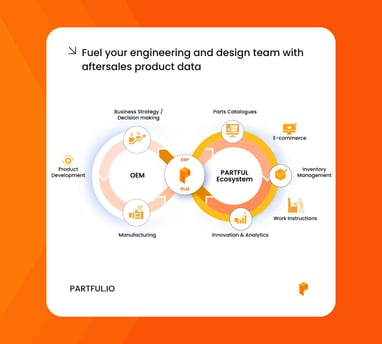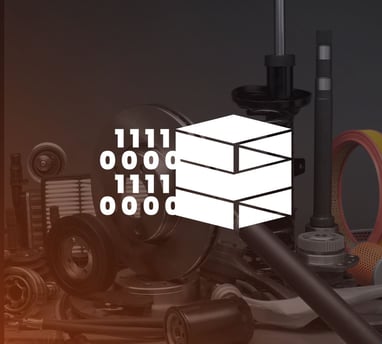Revving-up Aftersales: Embrace innovation or get left behind
In the high-speed world of manufacturing, clinging to outdated technology is like trying to win a drag race with a horse and cart. It's not just holding you back; it's practically ensuring you never cross the finish line.
With aftersales parts ordering processes and customer service often bogged down by inefficiencies, failing to innovate can quickly turn into missed opportunities and dwindling revenues.
It's time to gear up and stay ahead - your success depends on it.
In this blog, we're taking a deep dive into the sticky situations Original Equipment Manufacturers (OEMs) and their distributors get caught in because they're hanging onto outdated tech.
We'll also explore how adopting newer technologies and engaging in strategic partnerships can significantly impact your customer experience and parts revenue.
Where outdated technology causes the most harm
Transparency and Accessibility to Data
Outdated tech is a major roadblock in the efforts for streamlined data handling. It leads to information silos, muddles transparency across departments, and puts the brakes on swift decision-making.
The result? A significant dip in efficiency and productivity.
Everything's so fragmented. If you're an engineer or if you’re a procurement buyer and trying to find things, it’s just extremely excruciating - Roman Piszcz, Founder of Quotebeam
Collaboration
Legacy systems lack modern communication tools, hindering real-time collaboration and information sharing among teams.
Manual processes like emailing documents or using outdated software slow down productivity and teamwork.
Manual Work from A to B
Outdated tech means clinging to manual grunt work for tasks begging for automation—think data entry or managing inventory.
It's a time sink and a hotbed for mistakes, putting a dent in productivity and dragging out lead times.
5 outdated manufacturing technologies to scrap
1. Physical Technology e.g Fax Machines
Imagine this: You're knee-deep in paperwork and forms for new customers or vendors. This isn't a quick task; it can drag on for weeks.
In today's digital age, businesses shockingly still lean on fax machines for communication.
Sure, this method might seem convenient for those requesting manual work, but it completely overlooks the significant time and cost associated with manual labor.
We have a fully online business but we do have to accommodate legacy customers that their process is to take our cart, print it out as a PDF quote, then take it somewhere, make some notes on it, create a PO and scan both of those things in a physical printer, with those handwritten notes on it, and then attach that to an email. - Nikki Gonzales
Time to get out of the 90s and rethink this outdated process, don't you think?
2. Spreadsheets, PDFs and Paper for Data Management
Spreadsheets, PDFs, and paper represent an old-school approach to data management, but they're turning into more of a headache than a help.
Imagine a "Multiverse of Things": a chaotic universe where versions of data, part numbers, CAD files, and BOMs collide and create confusion. This isn't just a minor inconvenience; it's causing real problems, leading to incorrect orders and wasted resources.
The culprits? Excel sheets, PDFs, and paper-based manuals that quickly become outdated and are a nightmare to manage.
This disjointed approach not only leads to massive data discrepancies but also hinders parts buyers. They often end up selecting parts that are discontinued or have long lead times, all because they rely on legacy spreadsheets.
The lack of integration available for PDFs and Excel means that they're outdated as soon as they are created. This not only wastes time and money, but also forces customers to start the lengthy parts selection process from scratch after they discover they’ve got the wrong part.
The larger and more complex the organization, the more daunting this challenge becomes, and the risk of relying on outdated data skyrockets.
Even the big players in industries like automotive are struggling with this on a daily basis.
Consider the case of the Williams Racing FW46 2024 car arriving late to pre-season F1 testing, all because of an over-reliance on spreadsheets. It's clear evidence that even the most prominent brands can falter without a solid digital backbone.
“The Excel list was a joke. Impossible to navigate and impossible to update.” - Team Principal of Williams, James Vowles
But what if we could avoid all this back-and-forth and streamline the whole process?
The core issue here is the absence of an effective aftersales digital thread—a cohesive, integrated approach to managing data that keeps everyone on the same page and ensures that the information is always up to date.
It's time to bid farewell to the chaos of spreadsheets, PDFs, and paper, and welcome a more streamlined, efficient future.
3. Phone Calls & Email for Parts Ordering
It’s barbaric, right? But it’s not only true - 4 out of 5 OEMs we talk to operate using this process.
The reason is that whatever systems and tools they use for parts sales are not meeting the needs for parts identification and ordering for their dealers and end customers.
The outdated Excel sheets for a price list.
The PDF manual with 2D black and white diagrams.
The 2D static EPC that was developed in the early 2000s.
Today's buyers are accustomed to lightning-fast, hassle-free shopping provided by giants like Amazon - complete with next-day delivery. That's the benchmark now, not just for casual shoppers but also for your dealers and end-customers.
Picture the sheer frustration of transitioning from purchasing a picture frame on Amazon with just a couple of clicks, to being plunged into a chaotic treasure hunt through never-ending Excel sheets, PDF manuals, and cryptic 2D electronic diagrams.
It's time to step up your game and deliver the modern experience your customers deserve.
When it comes to orders received via phone or email, the margin for error is alarmingly high.
Mistakes are not just common; they're costly.
Imagine ordering the wrong part:
For the average vehicle owner, it's a frustrating wait without wheels.
For a B2B client, whose lifeline is their production line, it could mean bleeding millions in lost revenue.
It's easy to underestimate the impact of a seemingly insignificant part until you're the one left hanging. In the world of business, time is money. When high-salary teams like engineering and procurement are forced to chase down errors, the cost isn't just financial—it's operational.
In today's fast-paced world, who can afford to make these kinds of mistakes?
81% of OEMs believe they are losing revenue and operational costs due to inefficiencies in their aftersales and parts ordering processes. 67% of part buyers decide to buy from other sources. - Aftermarket Demand Report 2023
In the last three years, companies have been in a tight spot, grappling with how to keep customers happy amid the chaos of COVID-19 supply chain shortages. This crunch has sparked a flood of calls and emails, spiraling into a vortex of negative customer experiences. Waiting 6-8 hours for a response would be frustrating, right? That's been the reality for many.
A telling McKinsey study reveals a seismic shift in behavior: 75% of US shoppers explored new shopping avenues during and after the pandemic, shaking up long-standing brand loyalties. The game has changed, with manufacturers now putting a laser focus on exceptional customer experiences.
Don’t let disconnected Excel sheets and PDF 2D diagrams dampen your customer’s experience with your brand, product and service.
Providing a 3D interactive experience for finding and ordering parts can make your brand stand out and turn one-time buyers into lifelong fans.
Simply utilizing digital technologies does not equate to creating a digitized, autonomous supply chain — it also needs connected supply chain technologies across planning, procurement, manufacturing and logistics that work beyond the organization’s four walls. It’s the difference between “doing digital” and “being digital.” - EY
4. Disjointed systems that have not been updated in years
PLM (Product Lifecycle Management) and ERP (Enterprise Resource Planning) systems are often not interconnected, resulting in outdated and fragmented data.
Sales and Service Bills of Materials are not digitally integrated with CAD and Engineering Bills of Materials.
Some would argue there’s no issue with that.
We beg to differ.
When design engineers tweak CAD files or the Engineering Bill of Materials (EBOMs), there's a hitch: these updates don't automatically sync with the Service Bill of Materials (SBOMs).
It's a manual, labor-intensive process to bridge this gap. Often, the interim changes slip through the cracks, leaving teams working in isolation.
This disconnect can lead customers and dealers to make decisions based on outdated information.
This lack of cohesion leads to confusion and creates a bottleneck within organizations. With data scattered and only a handful of people knowing where to find what, making it difficult to adopt new processes and make them more efficient.
The aging population in Europe and the US is causing an even greater problem. Each day, around 10,000 baby boomers retire, taking their valuable tribal knowledge with them.
Last year, 2.2 million older workers retired earlier than expected, sharing only half of their job knowledge with those who will replace them.
We need to convert this knowledge into processes before it's too late.
For the past three or four decades manufacturing has been a very traditional, slow-moving industry. Manufacturing's done a great job in adopting technology for the product, but the way that product is being designed and developed has been really, really slow to the adoption of new technologies - Roman Piszcz, Founder of Quotebeam
5. Outdated static parts catalogs that don’t integrate into your PLMs or ERPs
Outdated, static 2D parts catalogs usually aren’t built with integration in mind. They often don’t connect with PLM or ERP systems which results in a poor parts-ordering experience for your dealers and customers.
Some issues caused by this lack of integration include:
1. Difficult to use ordering systems
Dealers face a nightmare when systems don't talk to each other. It's like trying to solve a puzzle with half the pieces missing. Not only is finding the correct parts a hassle due to a mismatch in information, but the need for multiple data entries across different systems adds to the chaos - further complicating parts ordering and stock management.
2. Outdated data & order errors
With a lack of integration, part names and numbers that are updated on one system are often left as legacy on another. This disconnect leads to ordering blunders and inventory headaches.
Ever heard of dark stock? It's the stuff in the back stock room, only known by the stock room attendant due to frequent changes in part names and numbers.
This elusive stock is a mixed bag of brands and white-labelled parts sharing part numbers, making it nearly impossible to track down and order correctly using disconnected systems.
3. Disconnected aftersales experience resulting in poor dealer experience
The bond between dealers and manufacturers is the cornerstone of a thriving manufacturing brand. But when dealers are stuck wrestling with subpar parts management systems, it strains this vital relationship.
A good relationship between the dealer and the manufacturer increases the likelihood of end-customers also having a positive experience.
If dealers aren't happy, it's a domino effect - they're less likely to provide top-notch service or recommend the best brand parts, ultimately tarnishing the end-customer's experience.
In a nutshell, sticking to outdated parts catalogs isn't just a minor inconvenience; it's a major roadblock in maintaining efficient and satisfying dealer and customer relationships. It's time for an upgrade to more integrated, dynamic and interactive systems.
How to harness smart tech for manufacturing excellence
Keep your data clean
In an era where connectivity defines success, the cleanliness and structure of your data – EBOM, MBOM, SBOM and CAD – cannot be overstated. As technology leaps forward, the power to harness its full potential lies squarely in the quality of your data.
For more information on what good data management looks like, read this article.
Start transferring knowledge now
Don't let vital knowledge become trapped within the confines of your organization. Too often, crucial information is hoarded in documents and spreadsheets by a single gatekeeper, risking loss with their departure.
It's time to break down these barriers with technology that ensures knowledge flows freely, securing your company's future.
Prepare for the Aftersales Digital Thread with connected systems
For manufacturing suppliers eager to broaden their horizons through online sales, the challenge of disconnected ERP systems looms large - it's important to note that most ERP systems aren't natively linked to e-commerce platforms.
The manual slog of data entry can throttle efficiency and growth. Choose a solution that bridges this gap, connecting your systems for a smoother, more productive sales journey.
Take a look at this breakdown from our Head of Marketing:
Work with the right technology partner
Elevating sales, productivity, and brand prestige demands more than mere technology; it requires the right partner.
Partner up with a provider who's not just in tune with the age-old challenges plaguing the manufacturing industry but also at the edge of the latest tech innovations, equipped to propel you to the forefront of your industry, ensuring you not only keep pace but set the pace.
Shifting gears towards next-level aftersales
In today's fast-paced world, being an early adopter of cutting-edge technologies isn't just cool—it's a game-changer.
Imagine giving your customers an experience so seamless and innovative that it not only meets, but exceeds, the expectations of the tech-savvy new generation, while also charming those who prefer the traditional ways.
That's not just an edge; it's your secret weapon against competitors lagging in the digital race.
The key? Choosing the right partner to tackle industry-specific challenges head-on. With the right ally, you're not just adopting technology; you're securing a competitive advantage that sets you apart.
Adopting technologies is not something that we should do in the future. This is something that we should have done yesterday, but we definitely have to do it today. - Roman Piszcz, Founder of Quotebeam
Want to hear more about outdated technologies within manufacturing processes? Listen to our podcast episode with guests, Roman Piszcz and Nikki Gonzales from Quotebeam.


